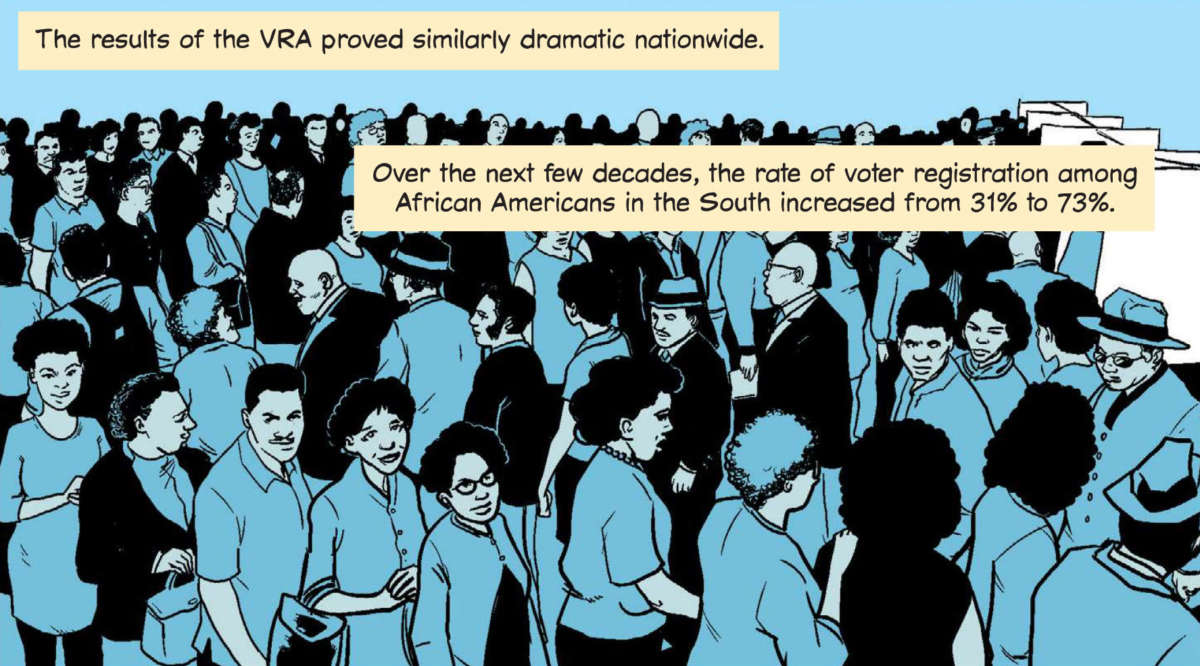Support justice-driven, accurate and transparent news — make a quick donation to Truthout today!
Below is an exclusive excerpt of the upcoming graphic novel Unrig: How to Fix Our Broken Democracy, published by First Second of Macmillan publishing and available July 7. Unrig, written by Daniel G. Newman with illustrations by George O’Connor, outlines key problems in U.S. democracy, proven solutions and stories of activists working to effect change. It documents the influence of money in politics, gerrymandering, voter suppression, the failings of the Electoral College, our current voting methods and more. The chapter below focuses on the history of voting rights in the United States and how to fight back against voter suppression.
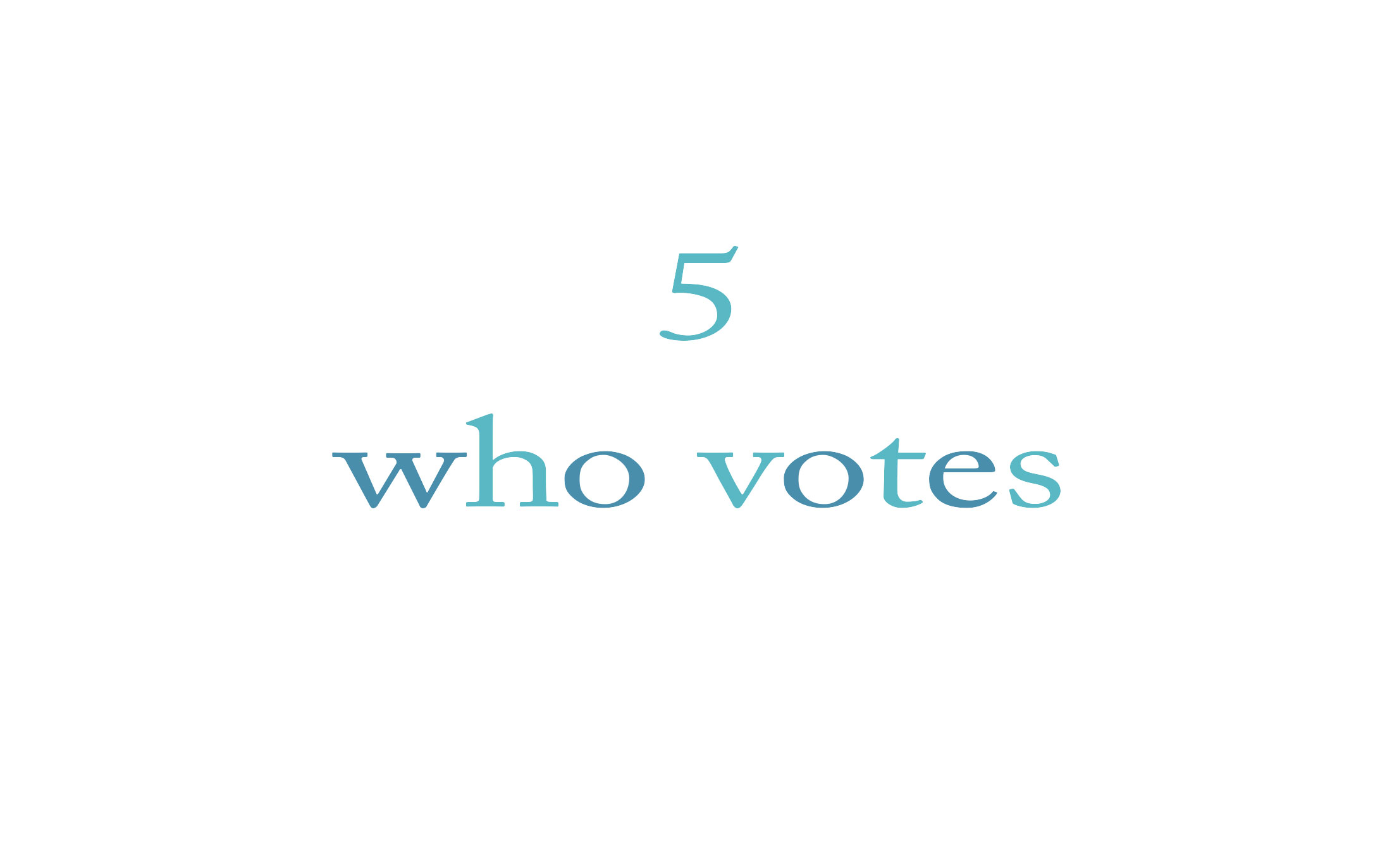
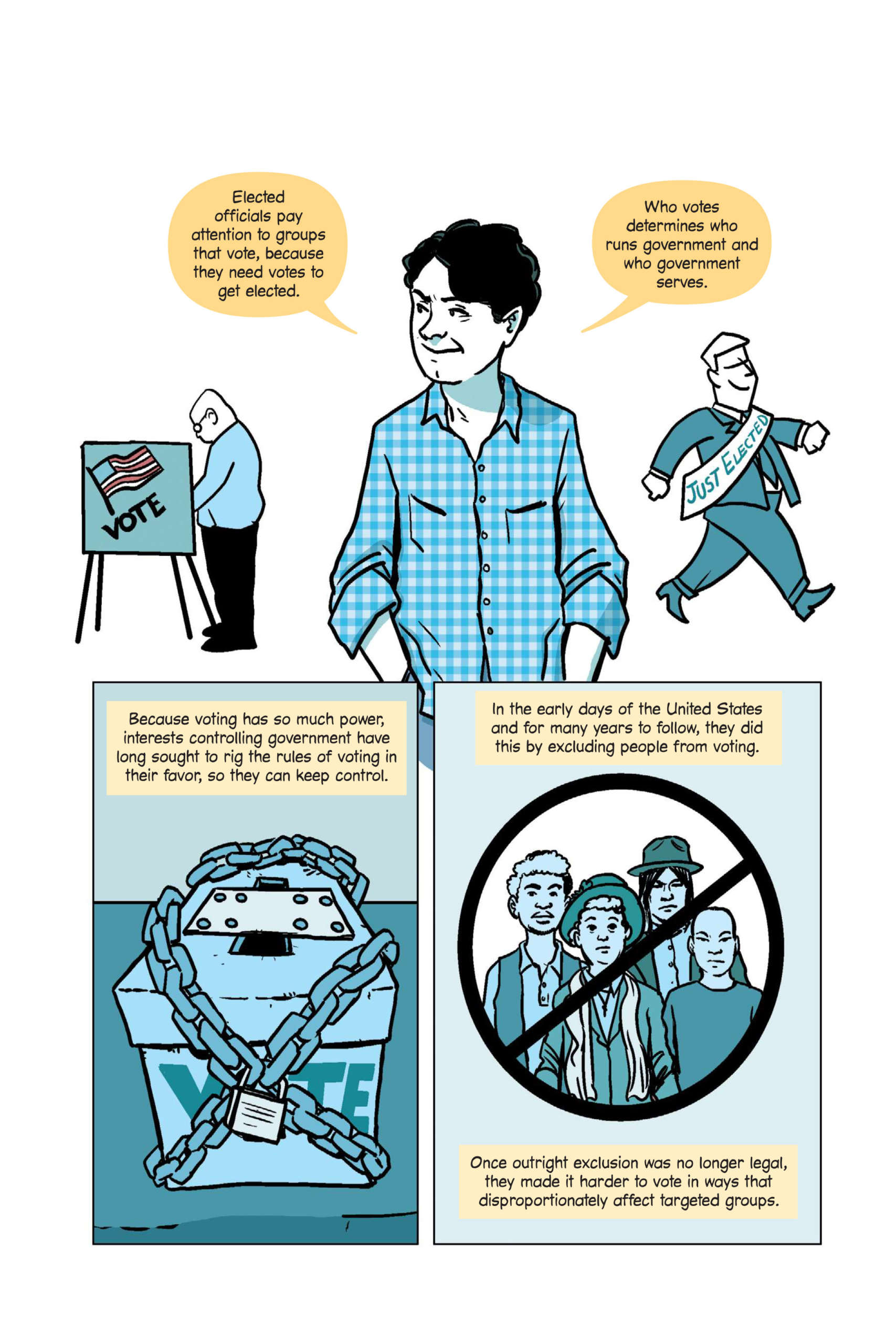
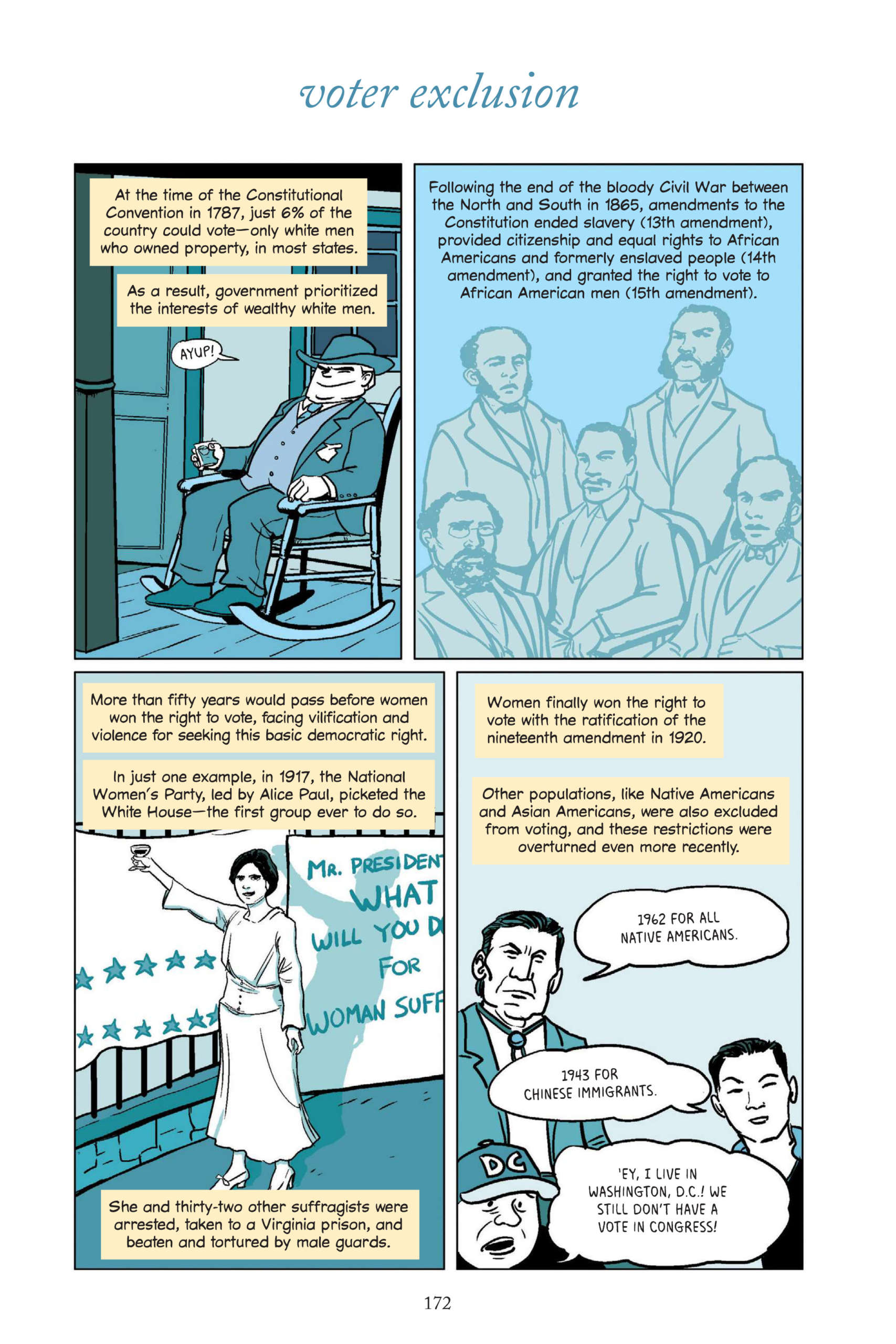
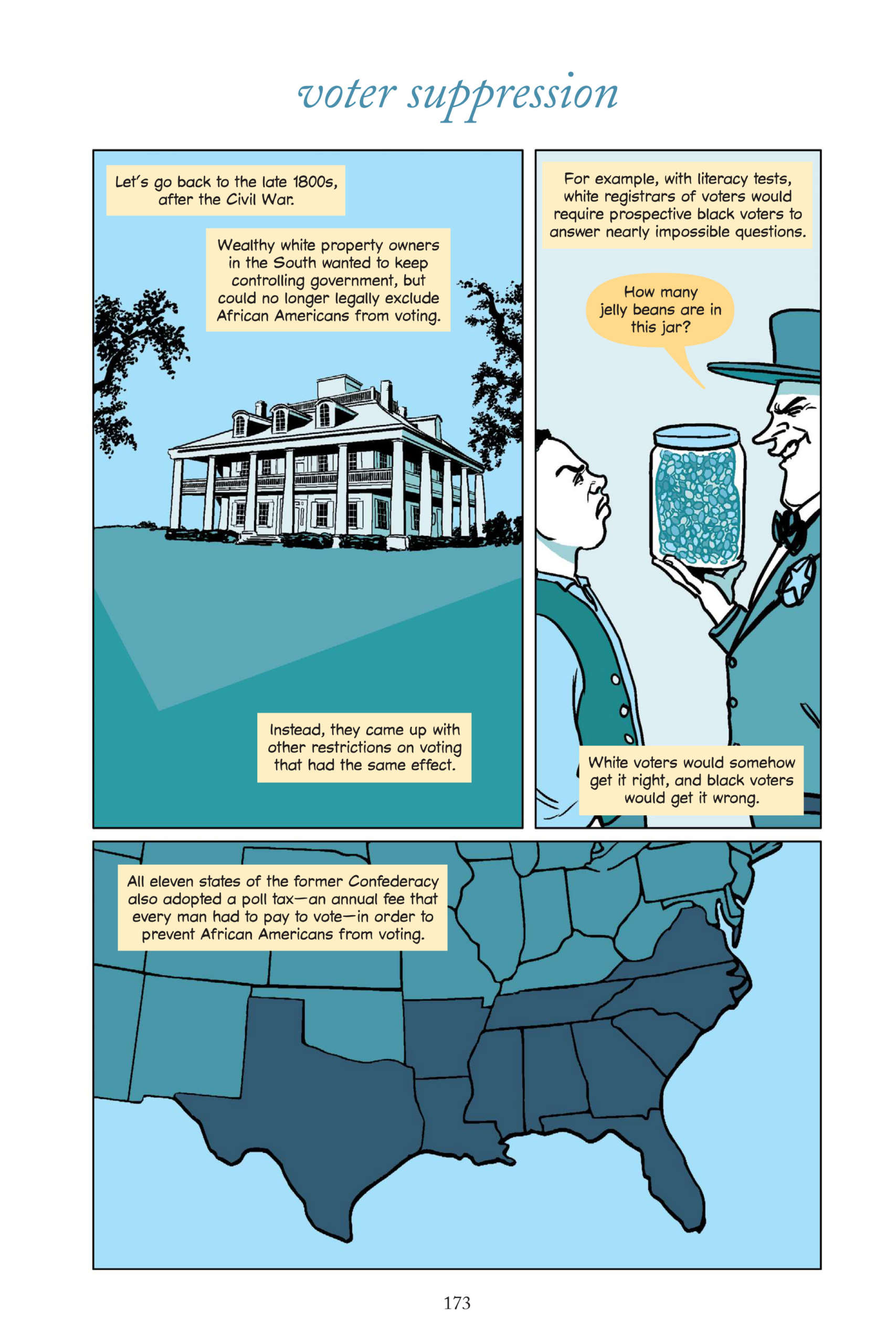
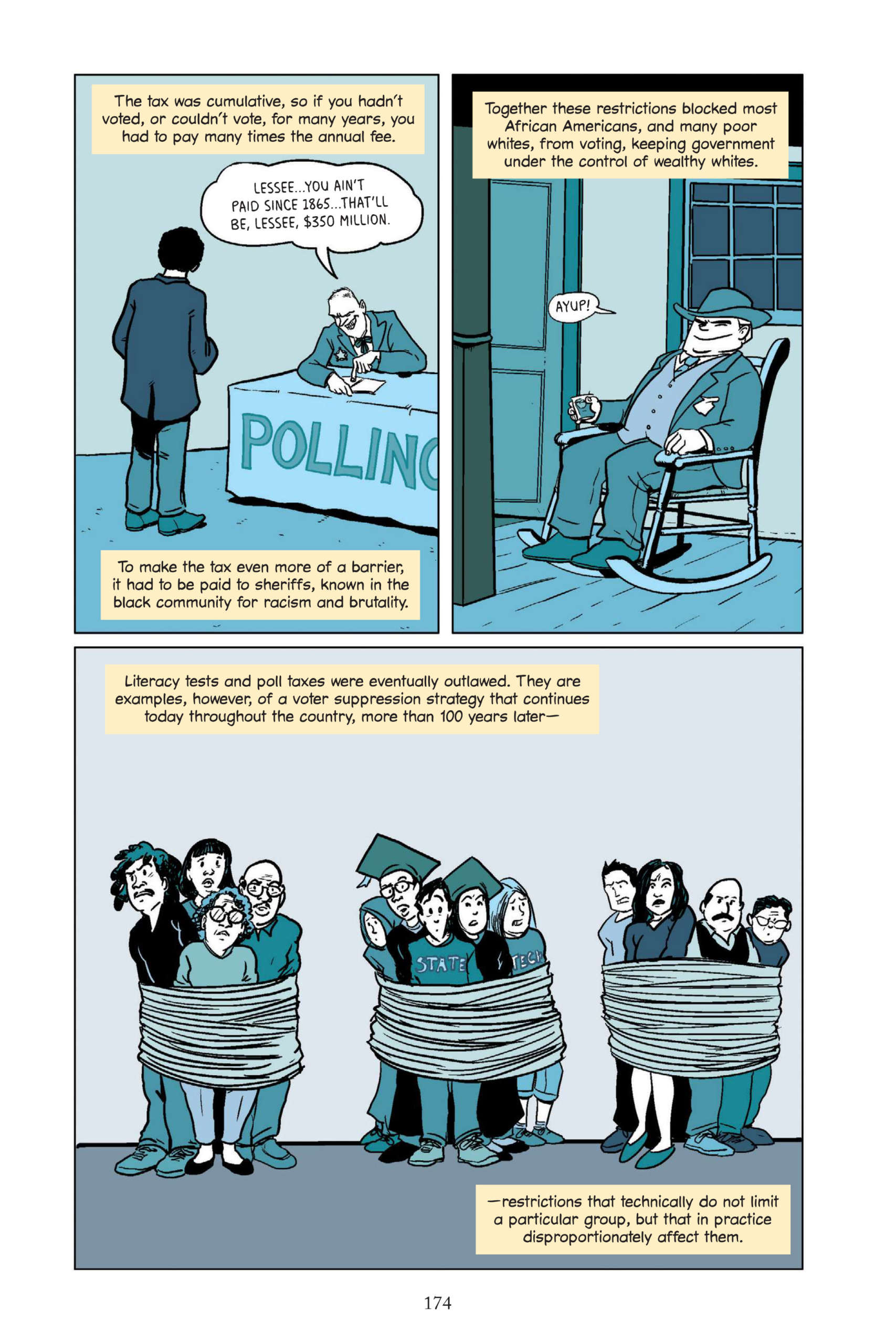
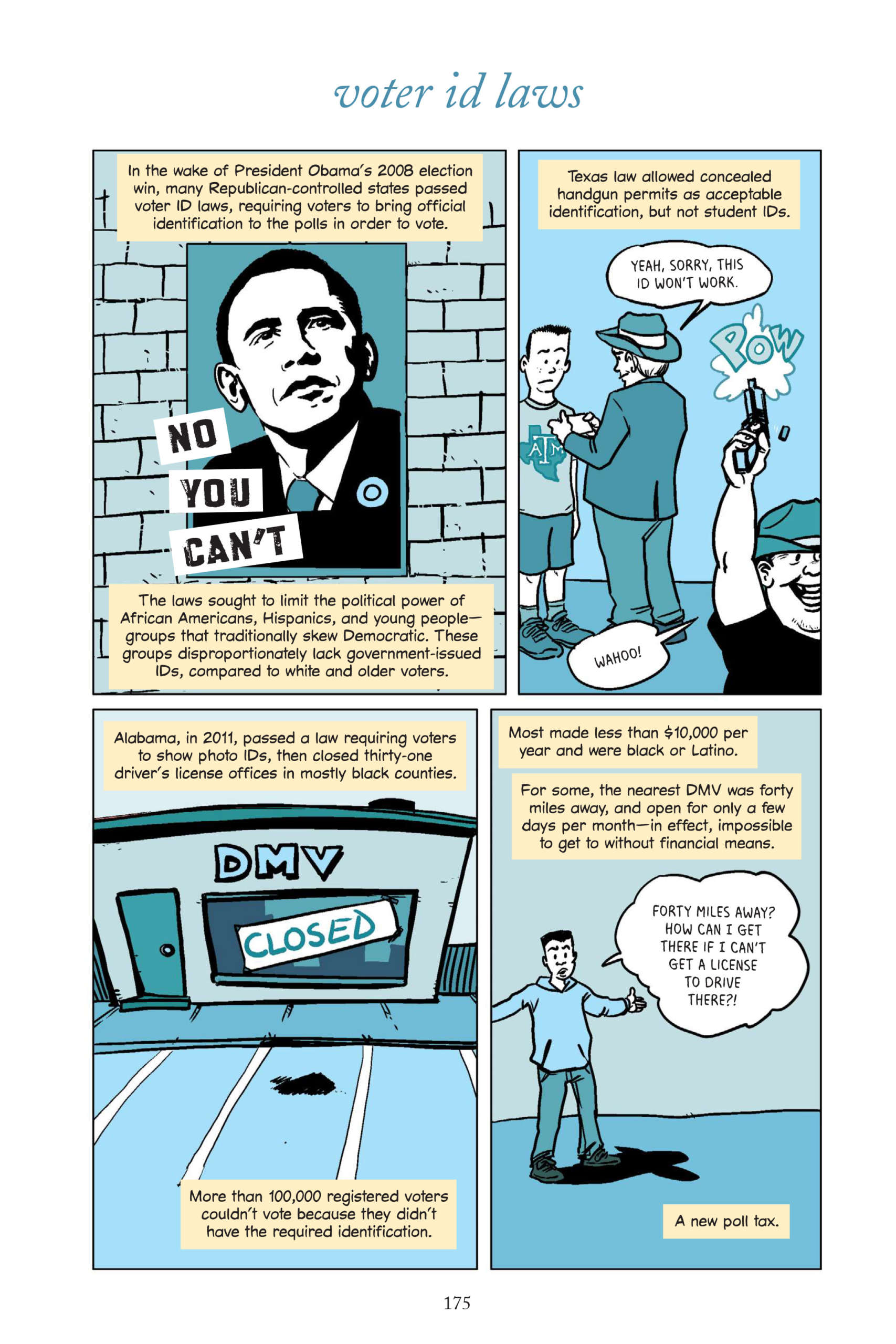
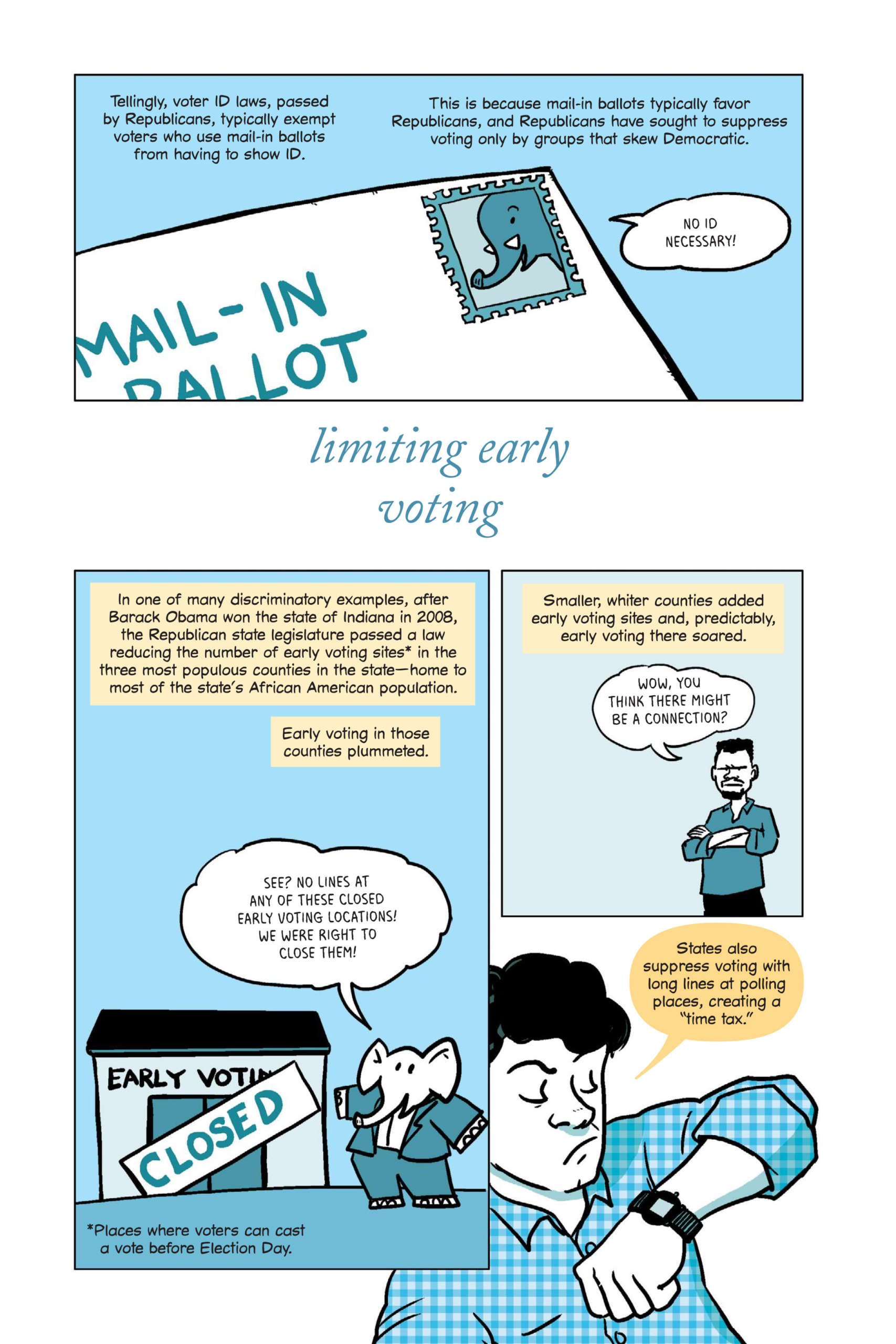
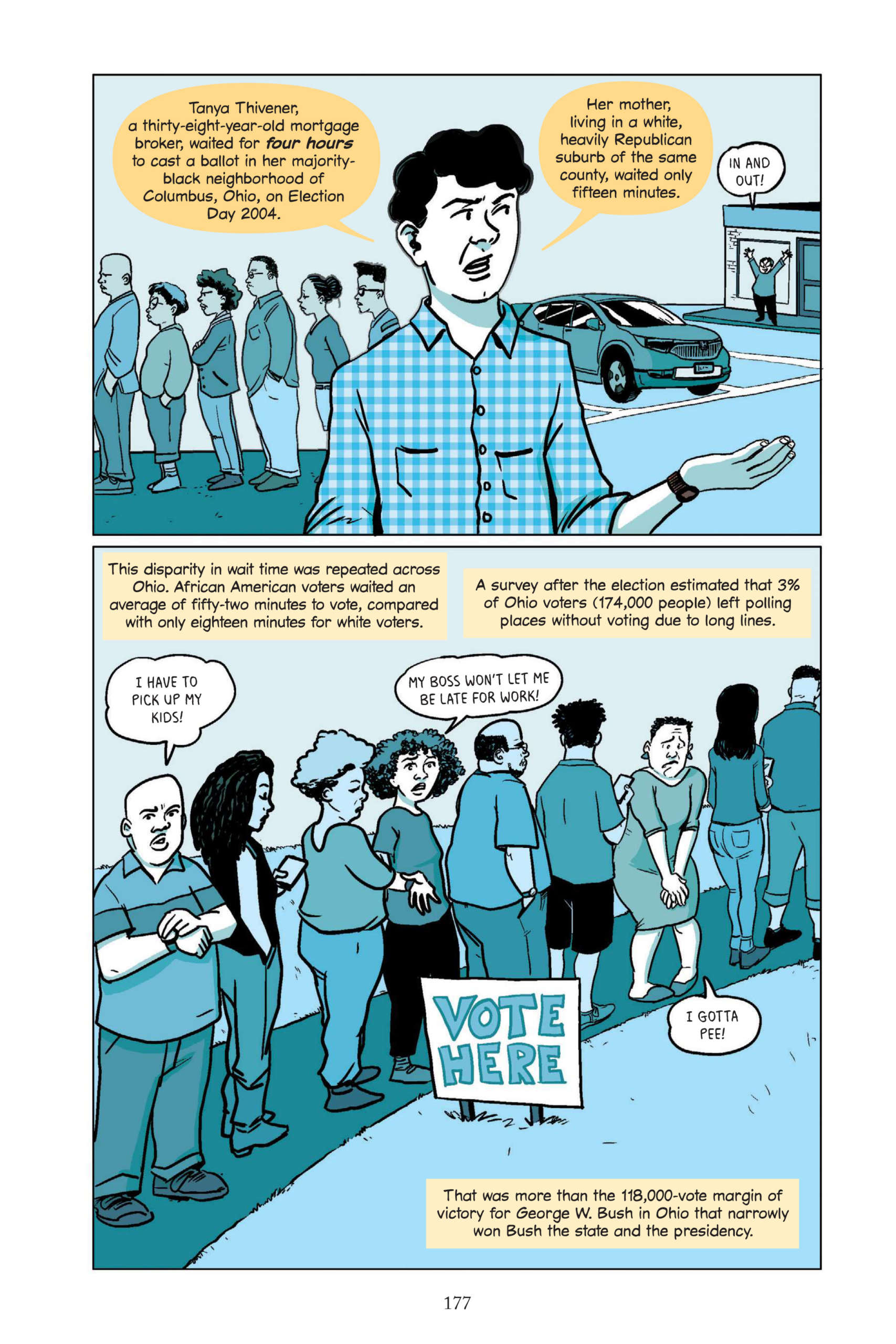
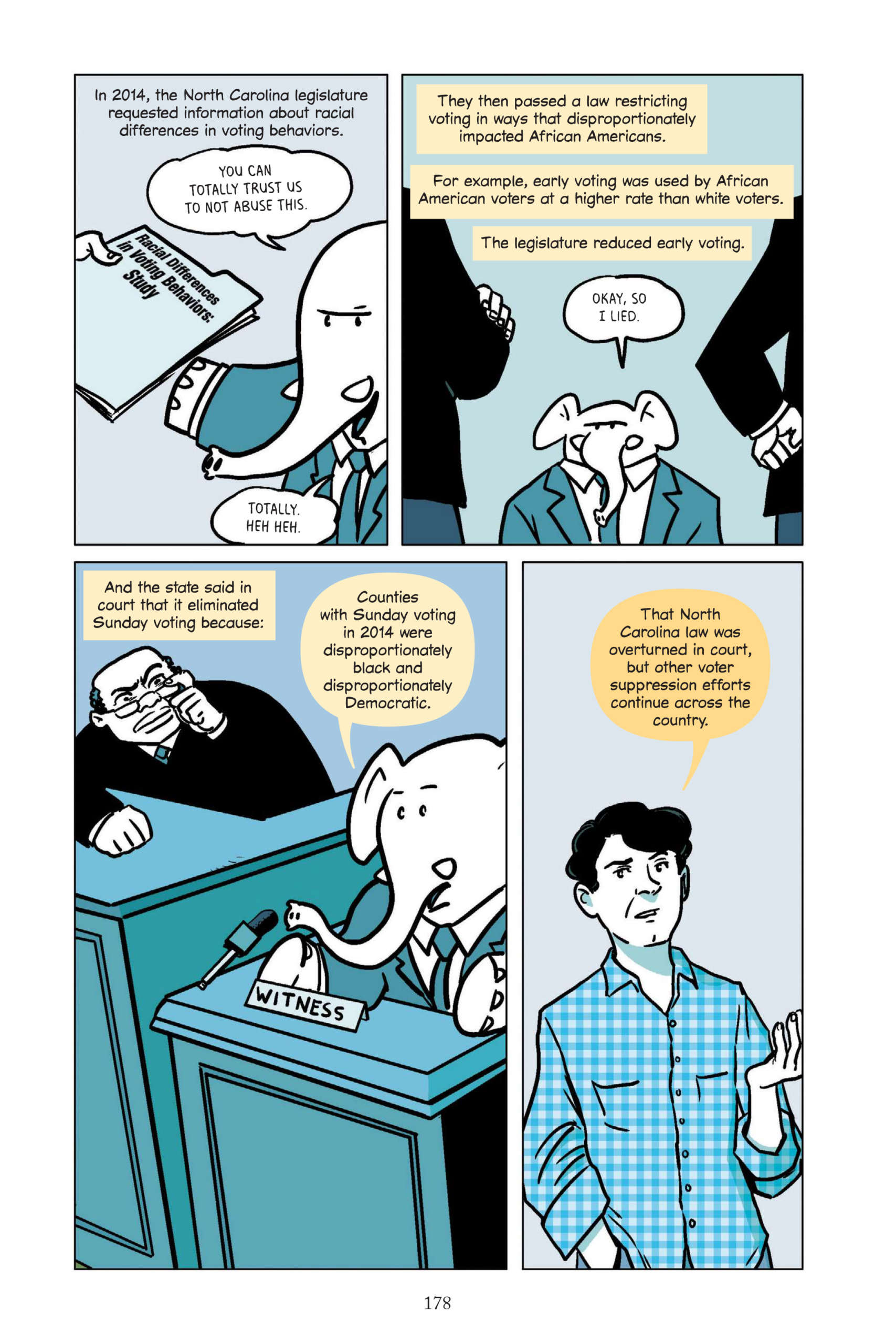
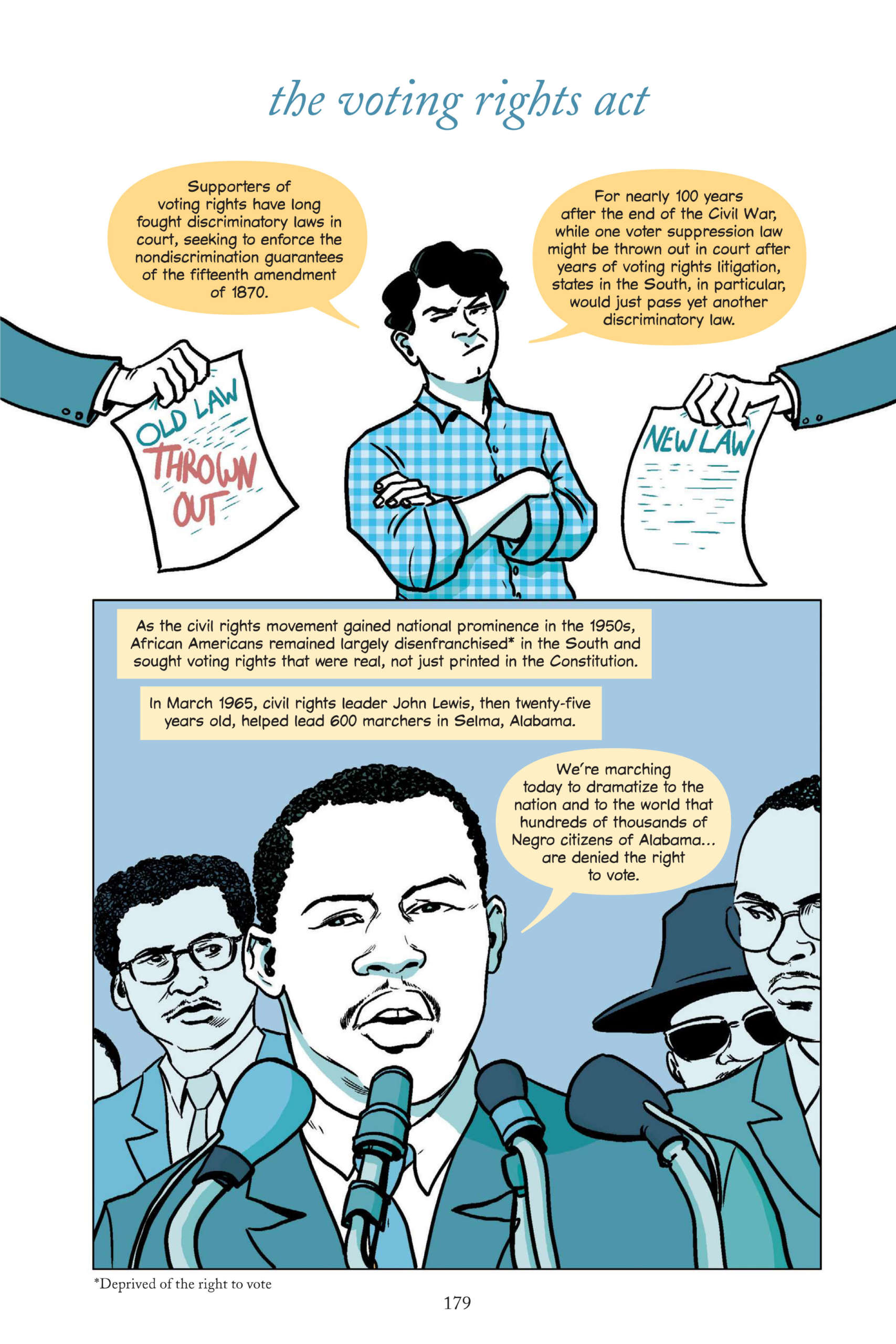
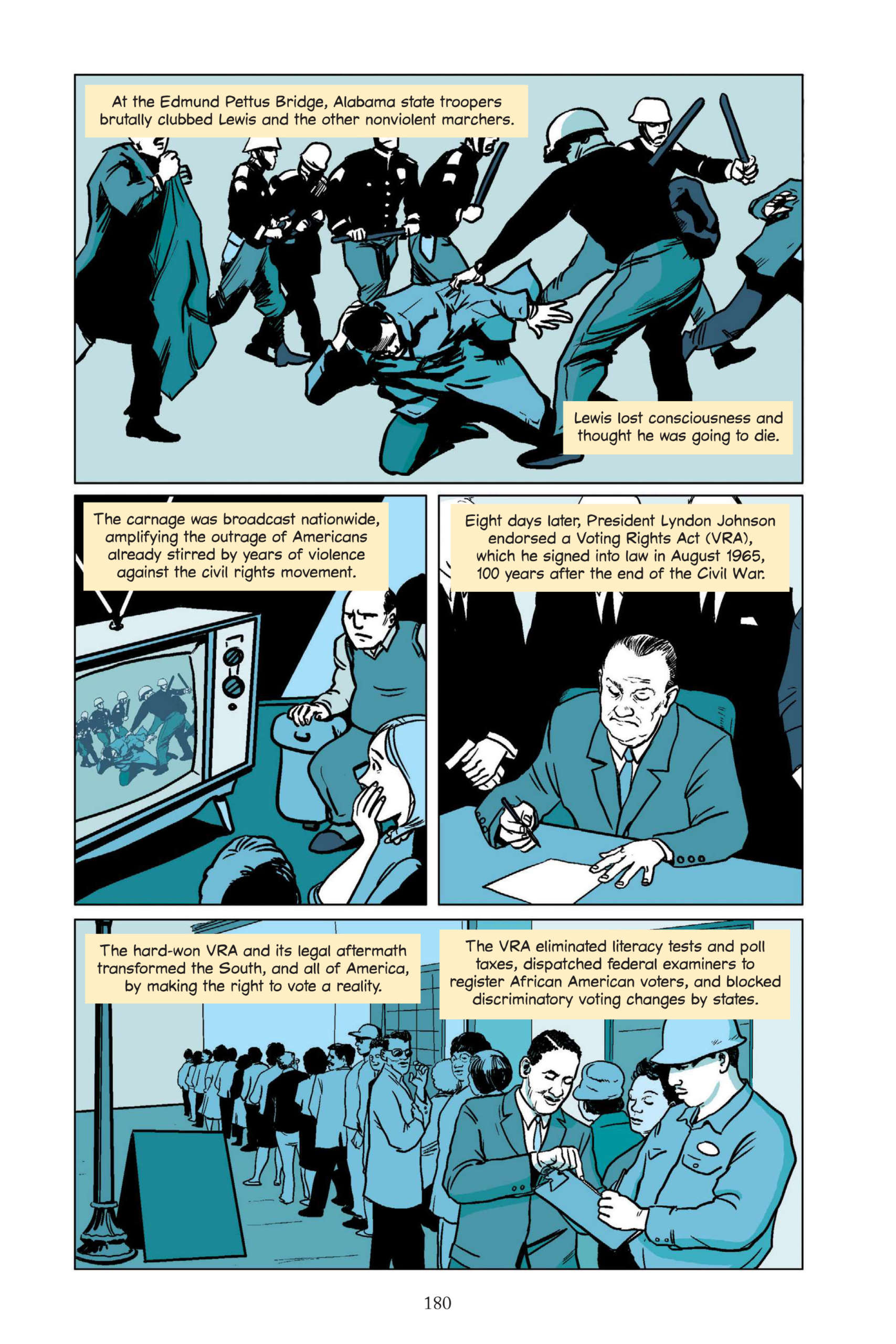
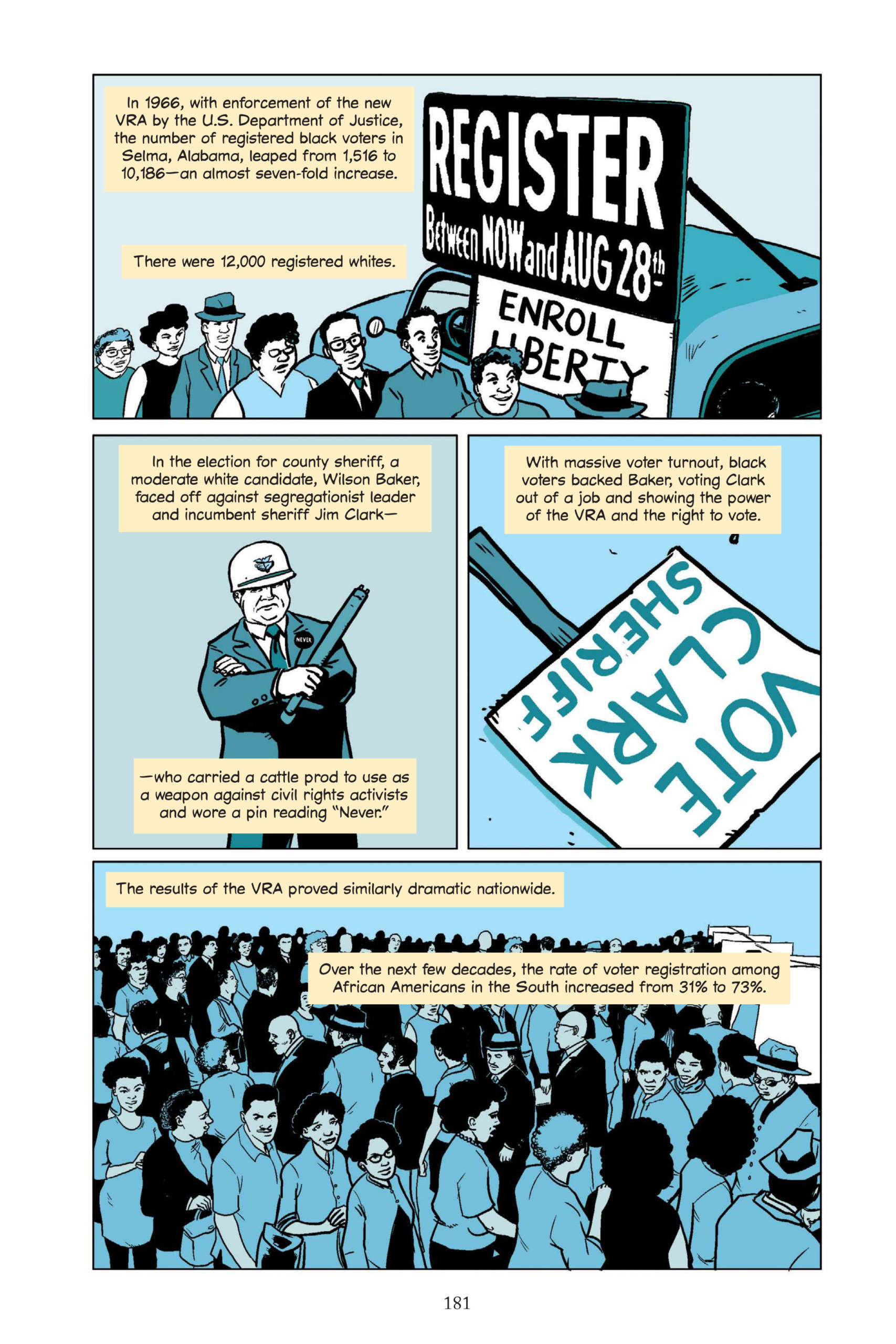

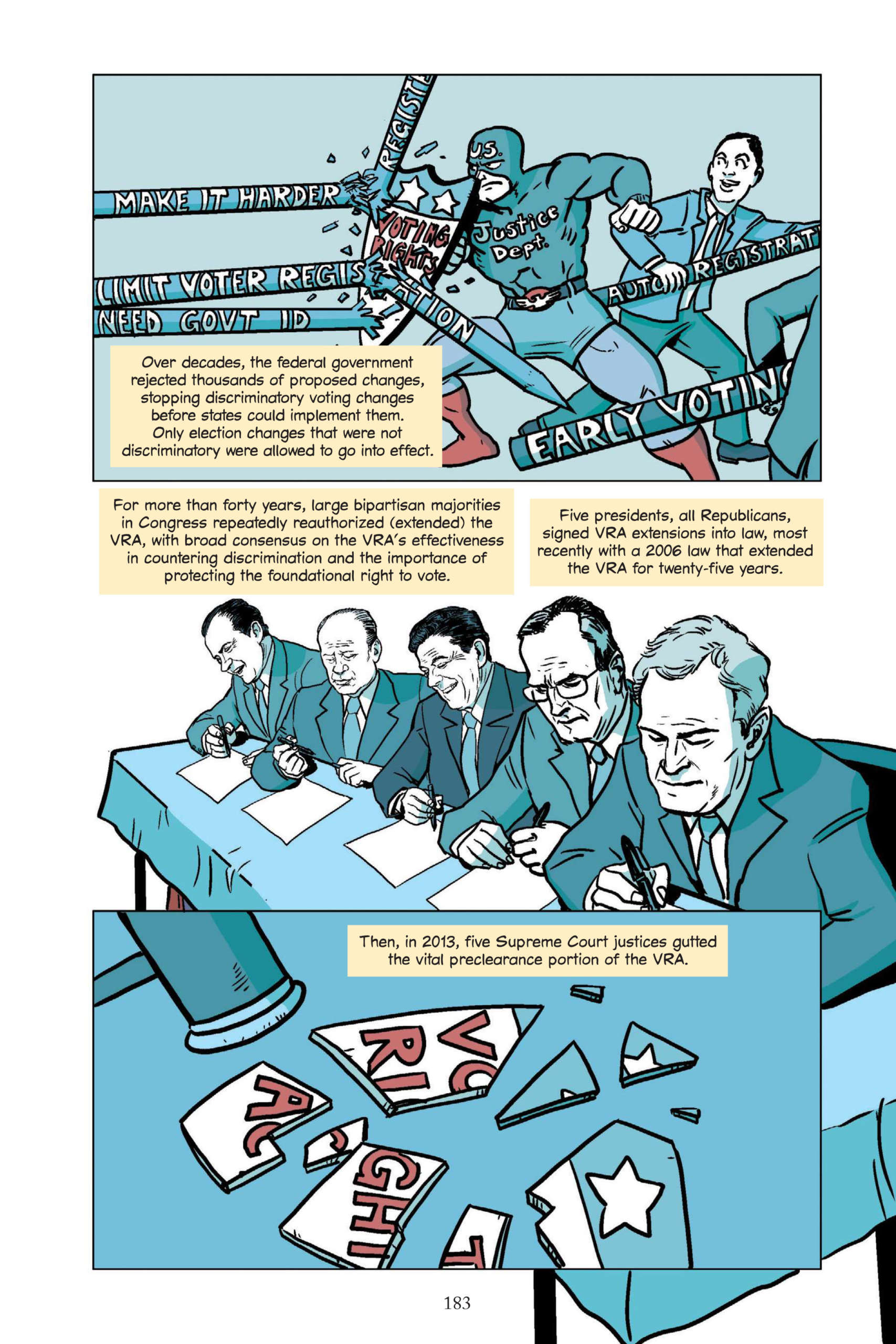
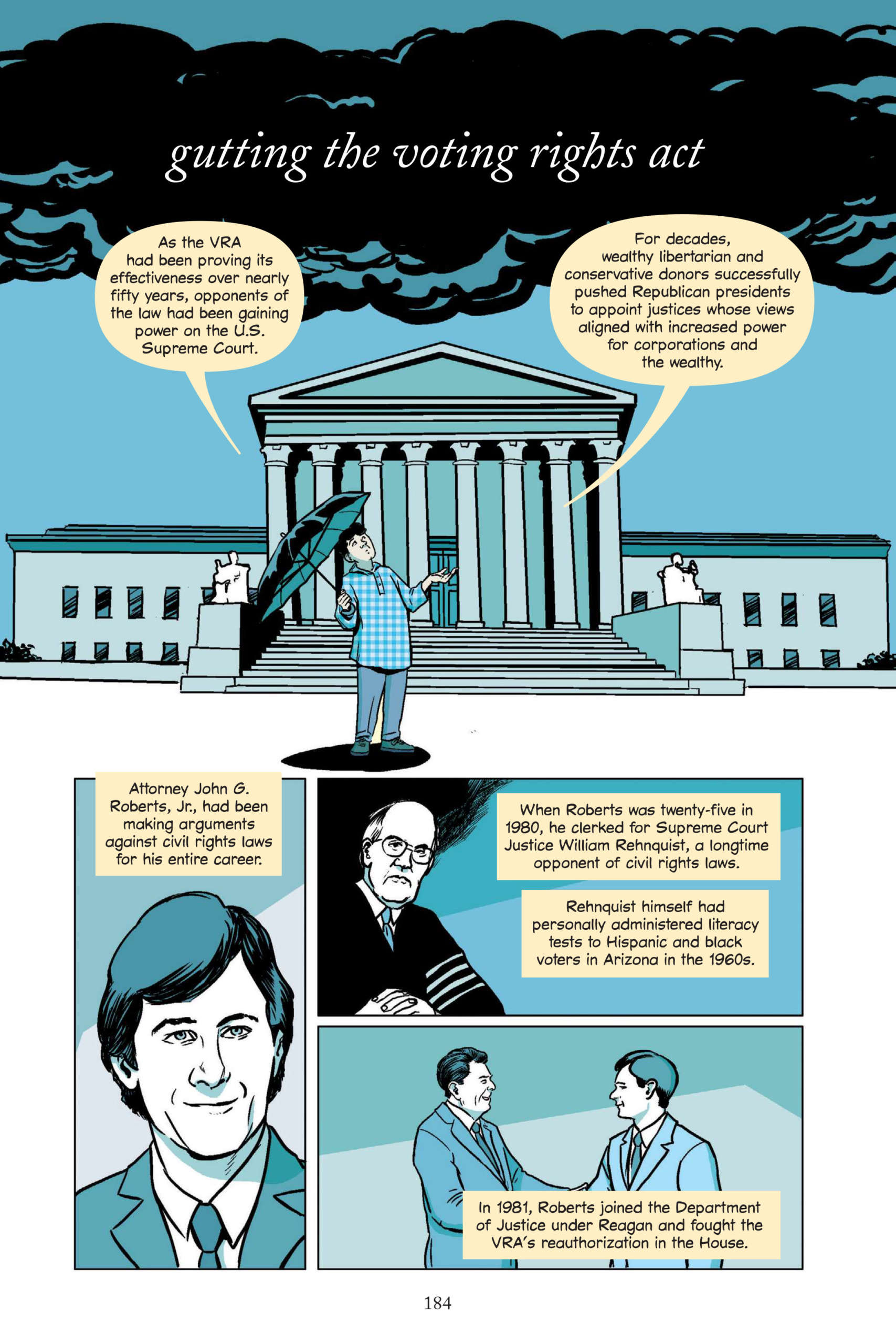
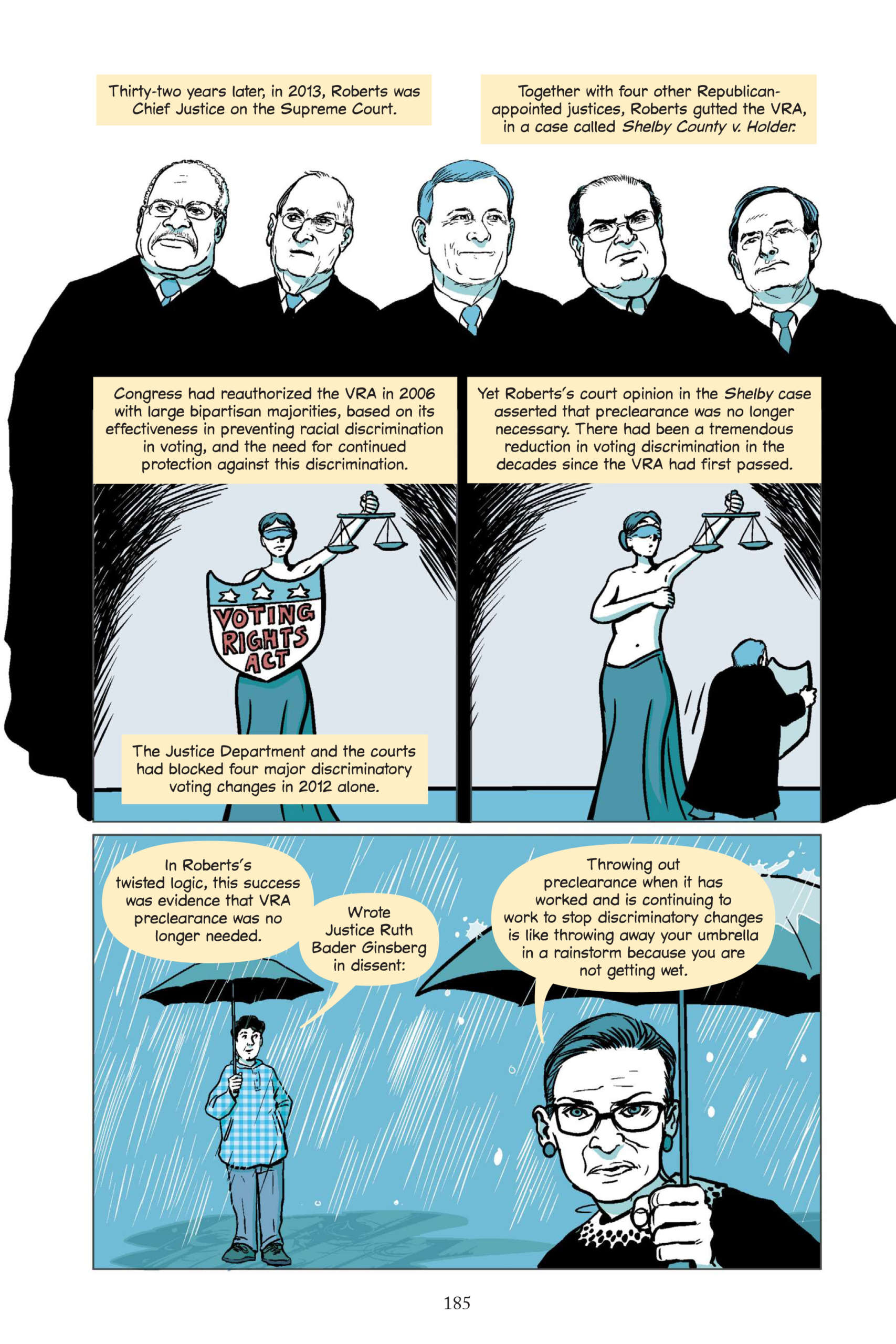
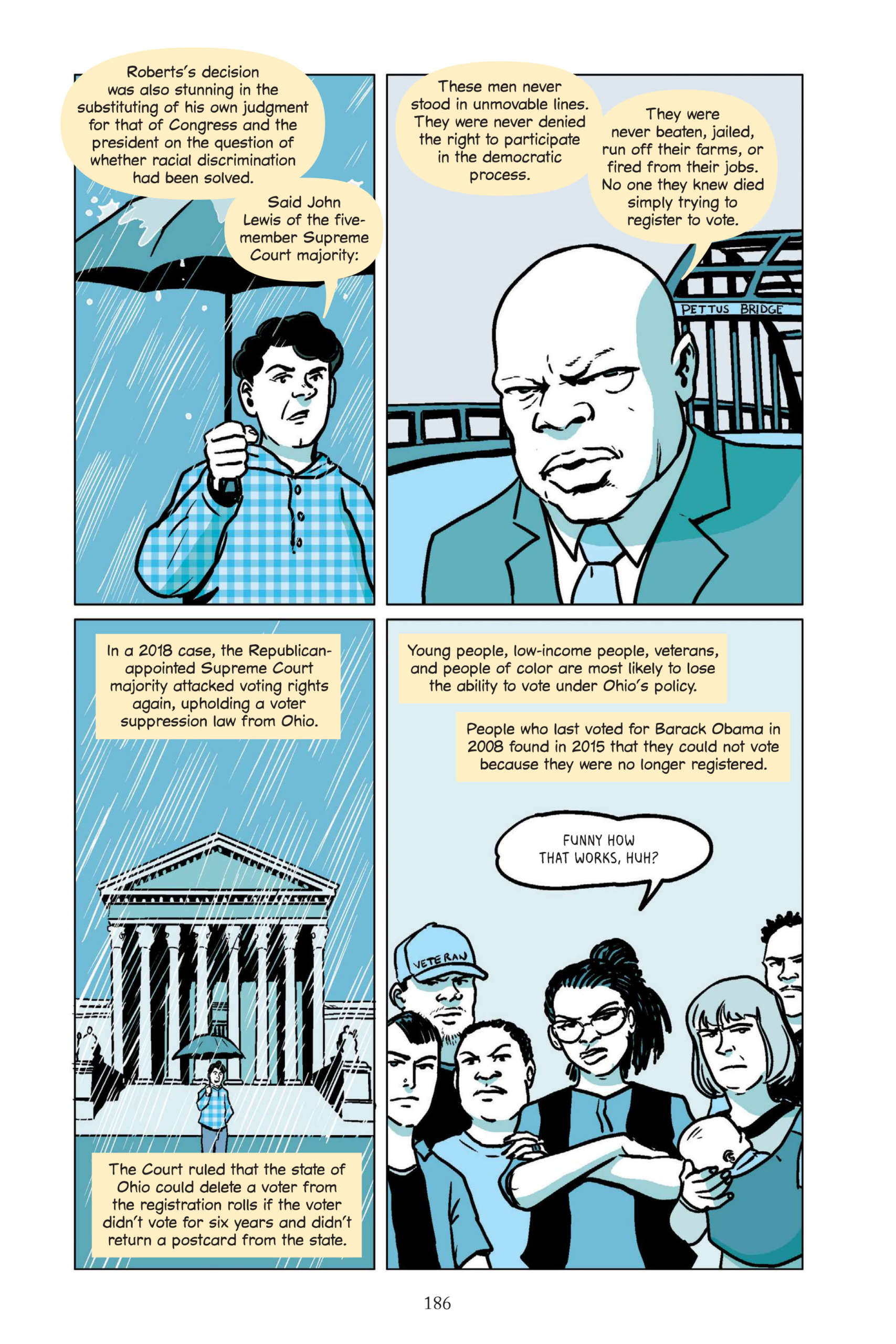
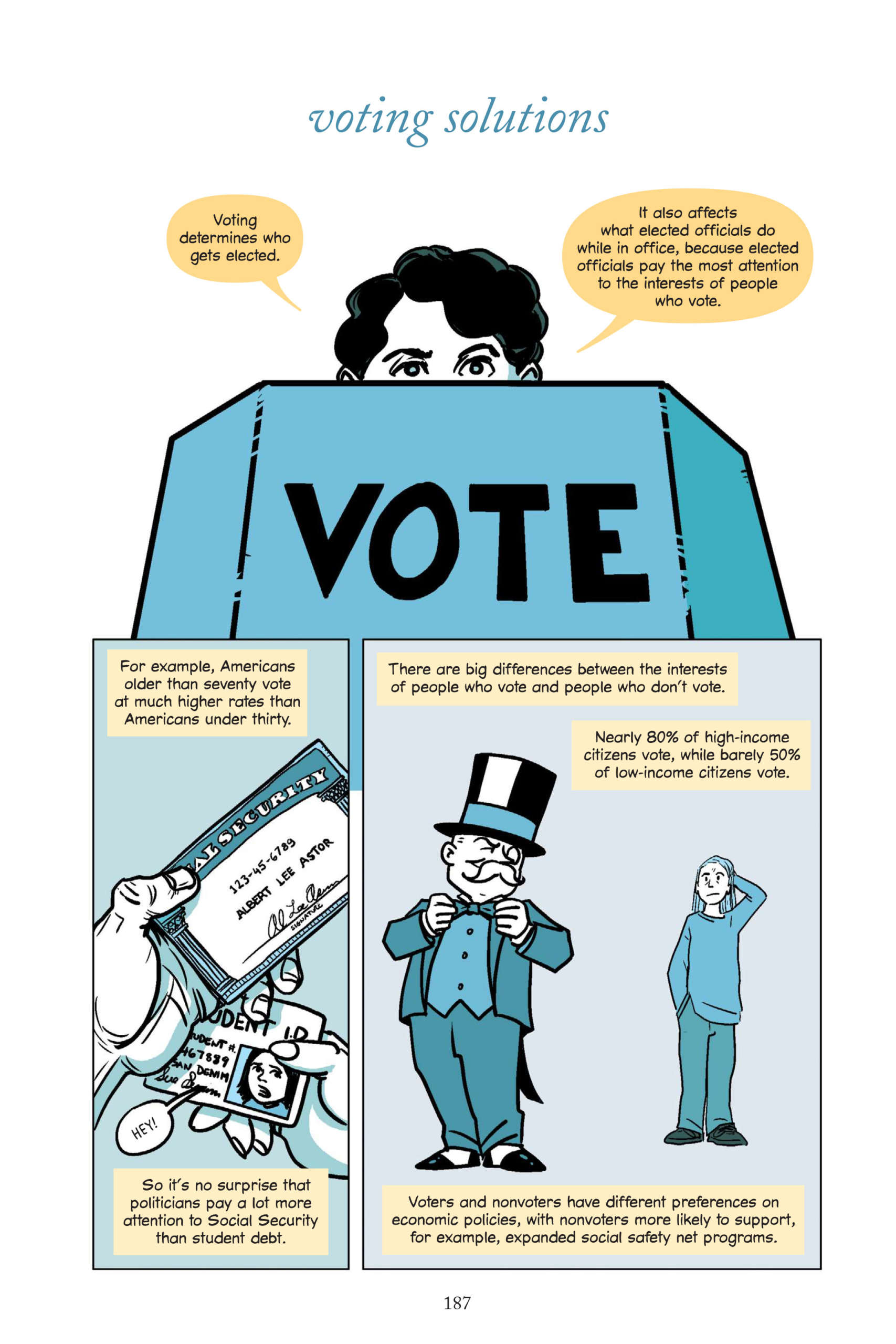
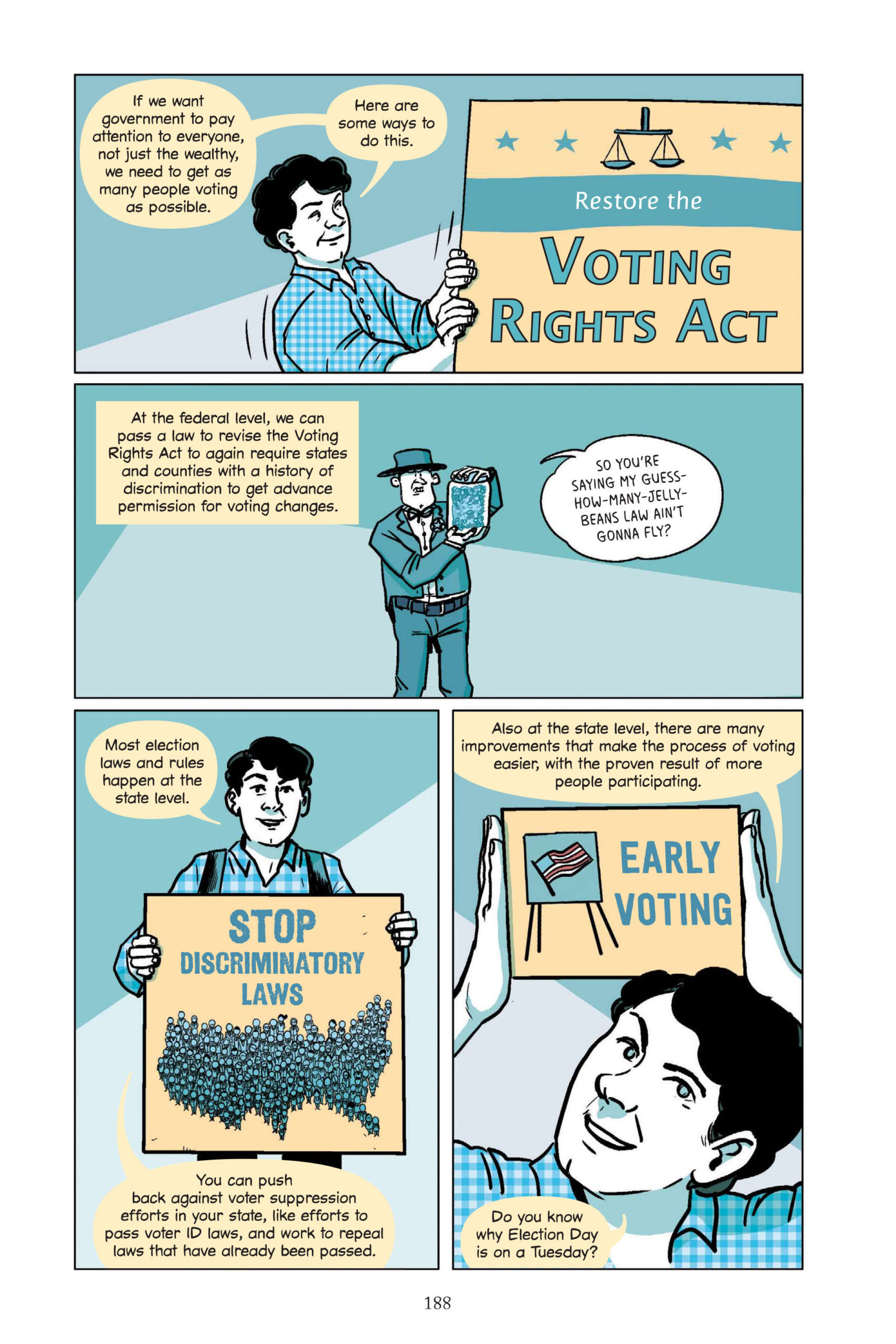
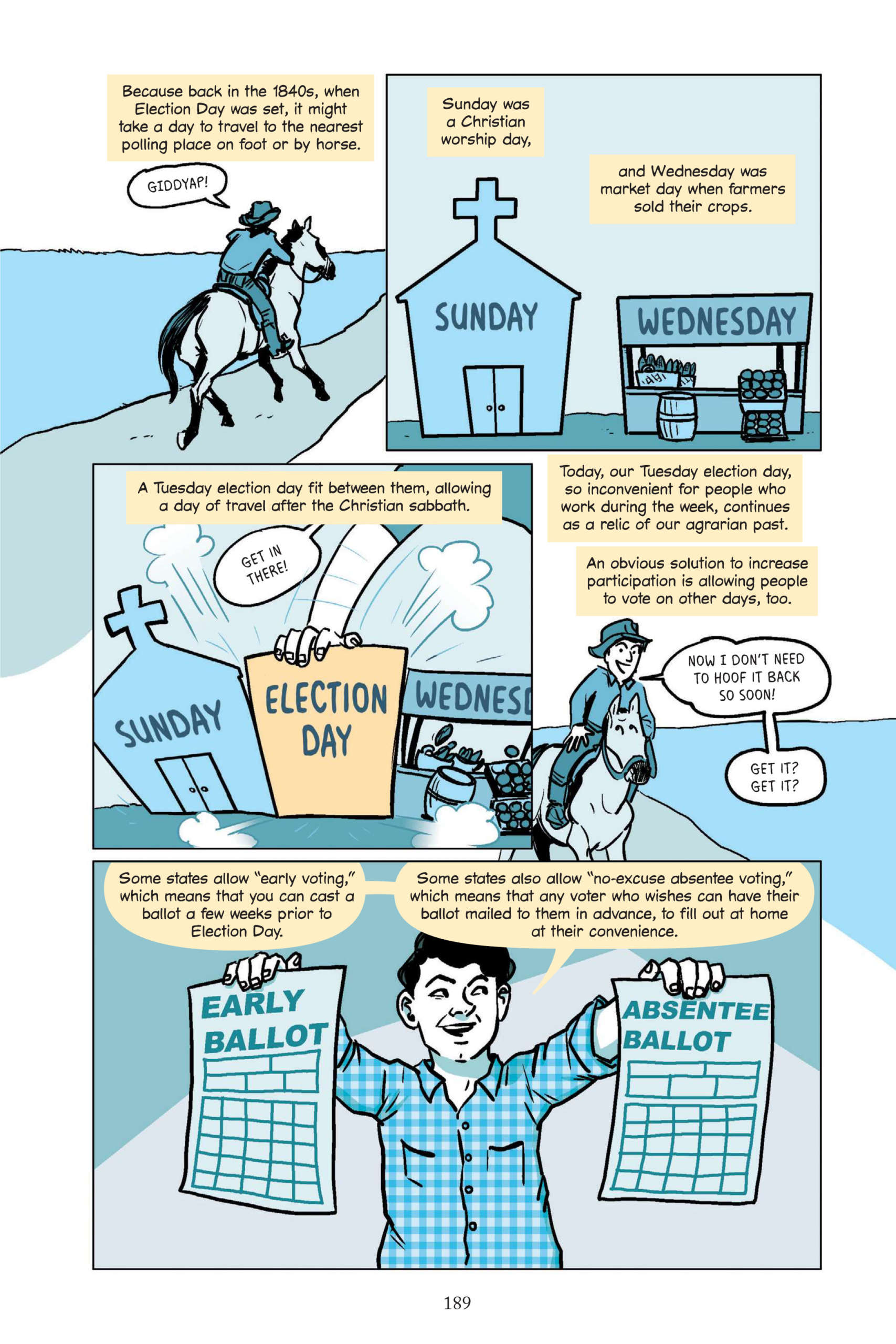
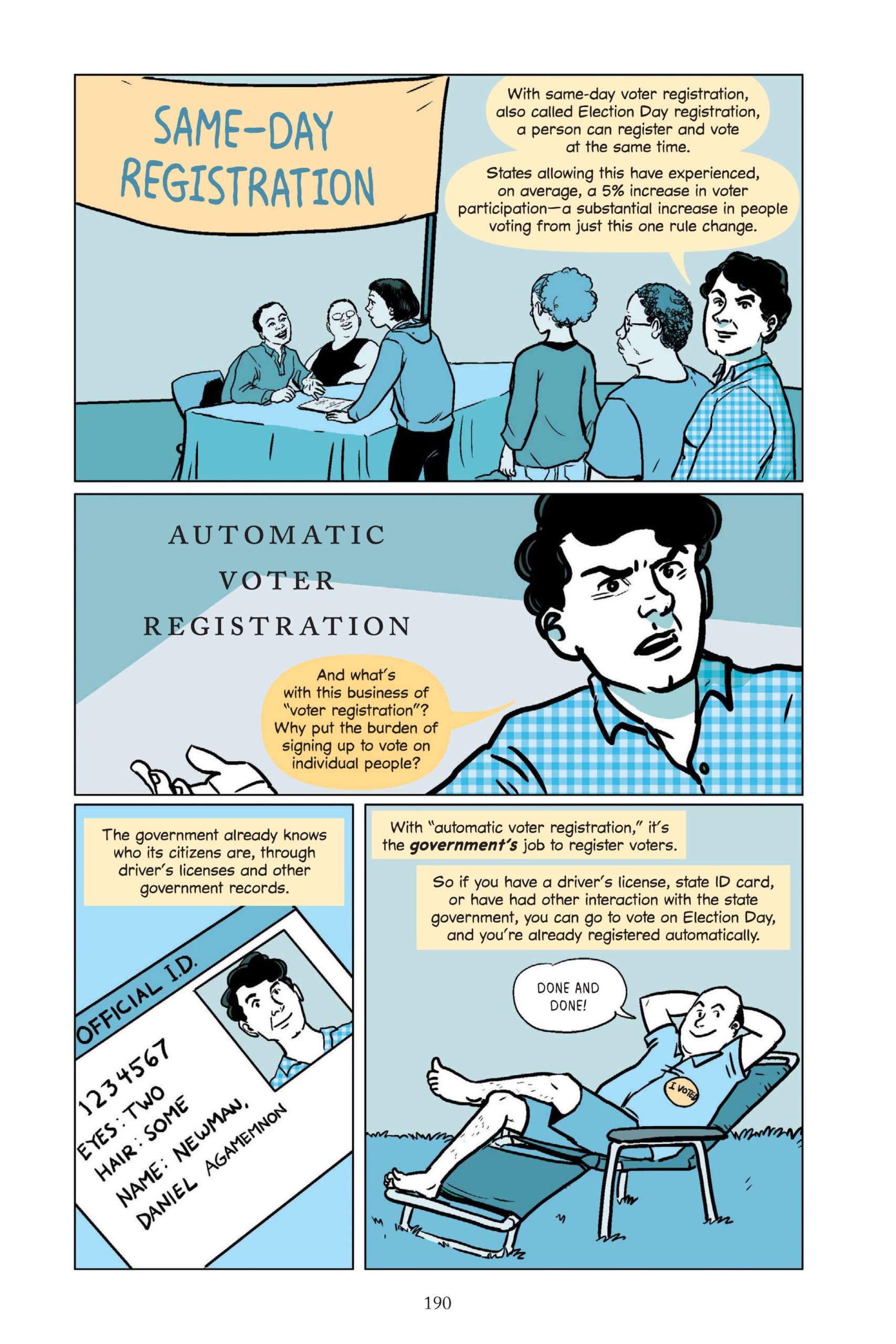
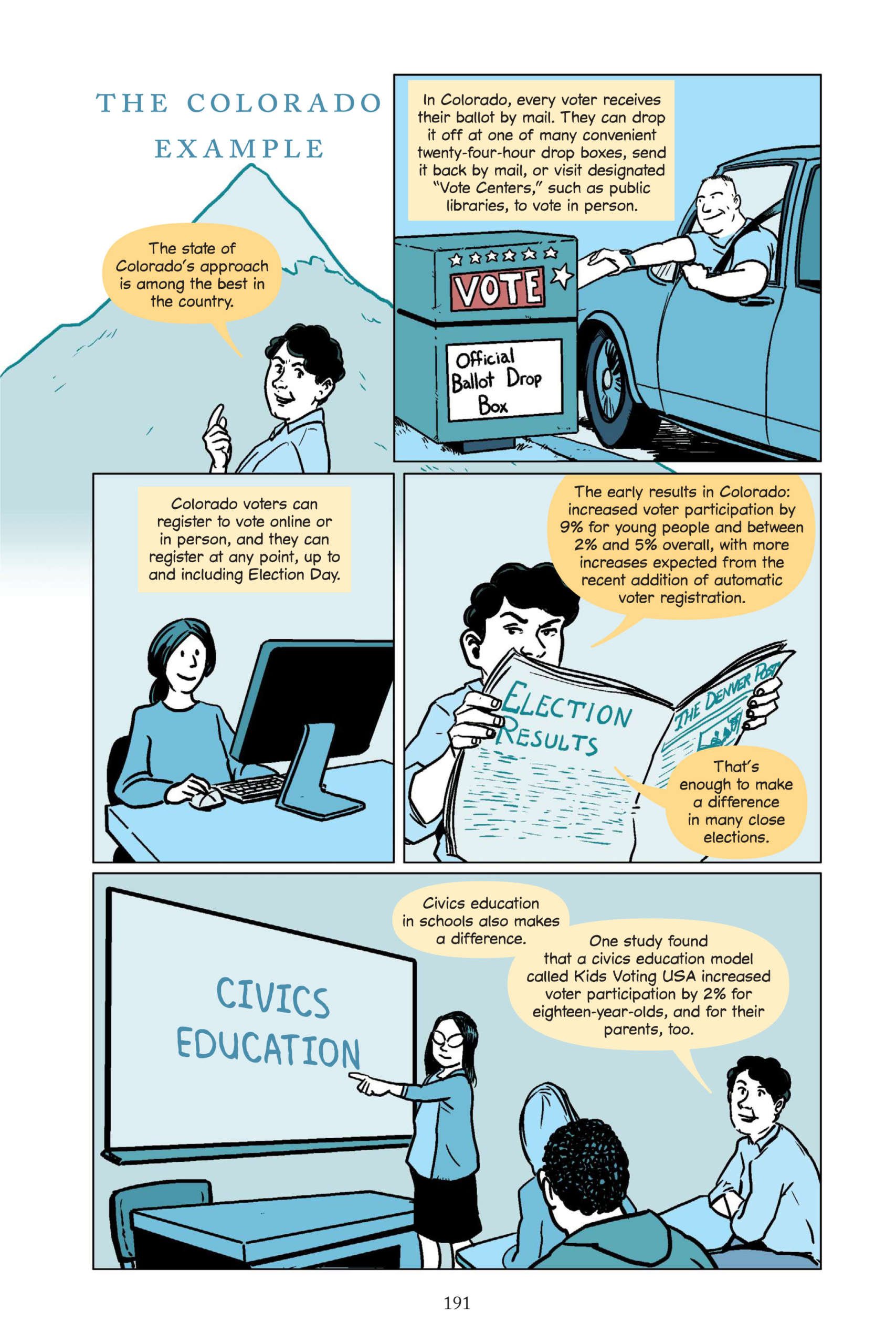
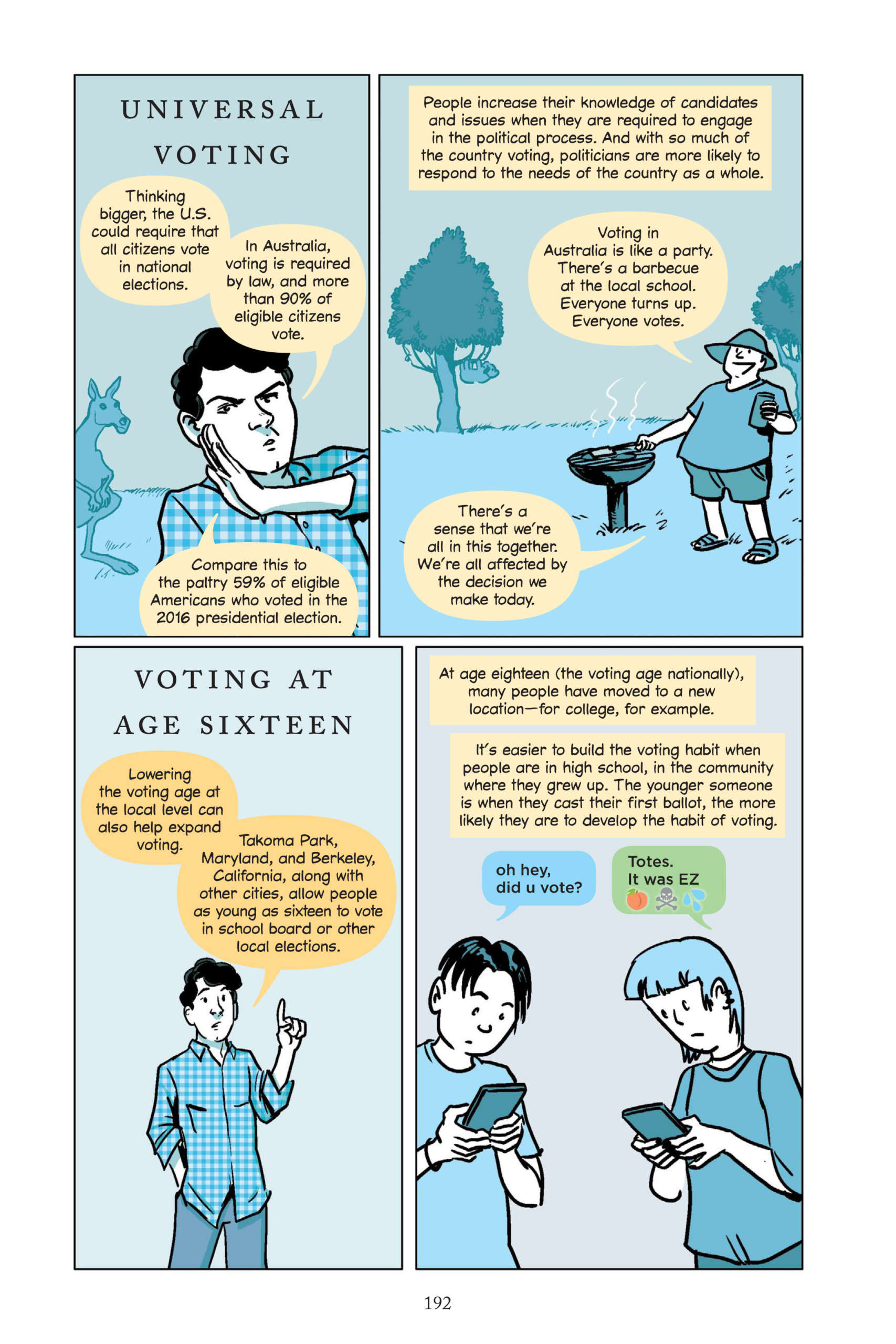
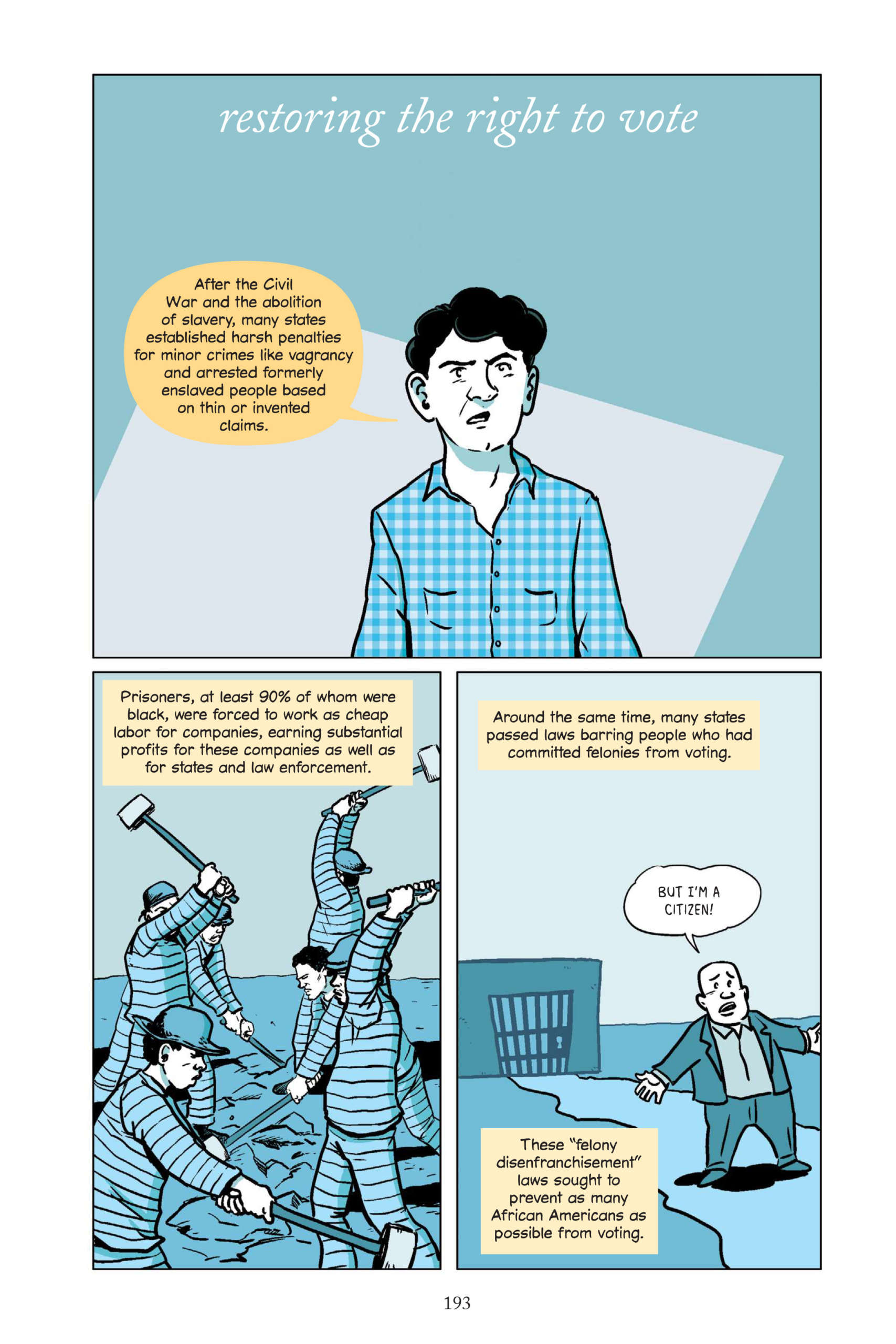

Get our free emails
Notes to chapter 5 – Who Votes
172 Six percent of country could vote in 1787: “How Things Have Changed in Philadelphia since the 1787 Convention,” National Constitution Center, May 25, 2016. constitutioncenter.org/blog/how-things-have-changed-since-1787.
172 National Women’s Party: Terence McArdle, “‘Night of Terror’: The Suffragists Who Were Beaten and Tortured for Seeking the Vote,” The Washington Post, November 10, 2017. washingtonpost.com/news/retropolis/wp/2017/11/10/night-of-terror-the-suffragists-who-were-beaten-and-tortured-for-seeking-the-vote/?utm_term=.659202fa071b; “First Picket of White House,” NewseumED. Accessed June 5, 2019. newseumed.org/tools/historical-event/first-picket-white-house.
172 Native Americans, Asian Americans excluded from vote: “Who Got the Right to Vote When?” Al Jazeera. Accessed June 5, 2019. interactive.aljazeera.com/aje/2016/us-elections-2016-who-can-vote/index.html.
173 Jelly bean test: Charles E. Cobb, Jr., “The Voting Rights Act, 45 Years Later,” The Root, August 6, 2010. theroot.com/the-voting-rights-act-45-years-later-1790880503; Associated Press, “Exhibit Traces History of Voting Rights Act,” MSNBC, August 5, 2005. nbcnews.com/id/8839169/ns/us_news-life/t/exhibit-traces-history-voting-rights-act/; Ari Berman, Give Us the Ballot (New York: Picador, 2015): 33.
173 All eleven Confederate states adopt poll tax: Kelly Phillips Erb, “For Election Day, A History of the Poll Tax in America,” Forbes, November 5, 2018. forbes.com/sites/kellyphillipserb/2018/11/05/just-before-the-elections-a-history-of-the-poll-tax-in-america/.
174 Voting laws restricted African Americans, poor whites: Carol Anderson, One Person, No Vote (New York: Bloomsbury Publishing, 2018): 7–9.
175 Many Republican-controlled states passed voter ID laws: Give Us the Ballot, 260.
175 Groups that traditionally skew democratic: “A Deep Dive Into Party Affiliation,” Pew Research Center, April 7, 2015. people-press.org/2015/04/07/a-deep-dive-into-party-affiliation/.
175 Texas law: Ibid., 257.
175 Alabama law: One Person, No Vote, 66–68.
176 Voter ID laws exempt mail-in ballots: Give Us the Ballot, 297; Mark Joseph Stern, “Vote Fraud Exists. Republican Restrictions Won’t Stop It,” Slate, September 1, 2016. slate.com/news-and-politics/2016/09/voter-fraud-exists-through-absentee-ballots-but-republicans-wont-stop-it.html.
176 Mail-in ballots typically favor Republicans: Liam Stack, “Millions Have Voted Early in the Midterms. Here’s What That Means—and What it Doesn’t,” The New York Times, October 23, 2018. nytimes.com/2018/10/23/us/politics/early-voting-midterms.html.
176 Indiana law: One Person, No Vote, 151–152.
176 “Time tax”: Stateline, “Voting Lines Are Shorter—But Mostly for Whites,” HuffPost, February, 15, 2018. huffpost.com/entry/voting-lines-are-shorter-but-mostly-for-whites_ b_5a85a1bbe4b00e7aba2d2978.
177 Tanya Thivener: Michael Powell and Peter Slevin, “Several Factors Contributed to ‘Lost’ Voters in Ohio.” Washington Post, December 15, 2004. washingtonpost.com/archive/politics/2004/12/15/several-factors-contributed-to-lost-voters-in-ohio/73aefa72-c8e5-4657-9e85-5ec8b2451202/.
177 Fifty-two minute average wait time: Give Us the Ballot, 221.
177 Ohio survey on leaving polling places: Ibid.
178 Voter suppression in North Carolina: Christopher Ingraham, “The ‘Smoking Gun’ Proving North Carolina Republicans Tried to Disenfranchise Black Voters,” Washington Post, July 29, 2016. washingtonpost.com/news/wonk/wp/2016/07/29/the-smoking-gun-proving-north-carolina-republicans-tried-to-disenfranchise-black-voters/.
179 John Lewis in Selma, Alabama: Give Us the Ballot, 5.
180 Voting Rights Act: Ibid., 5–6.
181 VRA effects on registered black voters in Selma: Ibid., 49.
181 Selma county sheriff election: Ibid., 49–53. 181 Jim Clark : Ibid., 16–17.
181 Results of VRA dramatic nationwide: Ibid., 6.
182 Lewis quote about Lyndon Johnson: Ibid.
182 Preclearance provision in Voting Rights Act: “The Voting Rights Act,” Brennan Center for Justice. Accessed June 5, 2019. brennancenter.org/issues/the-voting-rights-act.
183 Federal government rejected thousands of discriminatory voting law changes:
Andrew Cohen, “After 50 Years, the Voting Rights Act’s Biggest Threat: The Supreme Court,” The Atlantic, February 22, 2013. theatlantic.com/national/archive/2013/02/after-50-years-the-voting-rights-acts-biggest-threat-the-supreme-court/273257/.
183 Voting Rights Act extended for twenty-five years: Jeffrey Toobin, “Voter, Beware,” The New Yorker, February 22, 2009. newyorker.com/magazine/2009/03/02/voter-beware.
183 Supreme Court guts preclearance provision of VRA: Adam Liptak “Supreme Court Invalidates Key Part of Voting Rights Act,” The New York Times, June 25, 2013. nytimes.com/2013/06/26/us/supreme-court-ruling.html.
184 John Roberts clerk for William Rehnquist: Give Us the Ballot, 146.
184 Rehnquist literacy tests: Ibid., 147.
184 Roberts’s opposition to VRA reauthorization: Ibid., 149.
185 Justice Department, courts block four discriminatory voting changes: Ibid., 277.
185 Ruth Bader Ginsburg quote: Ibid., 281.
186 John Lewis quote: Ibid., 283.
186 Ohio voter suppression law upheld: Richard Wolf, “Supreme Court Says States Can Remove Voters Who Skip Elections, Ignore Warnings,” USA Today, June 11, 2018. usatoday.com/story/news/politics/2018/06/11/supreme-court-states-purge-voters-who-dont-vote/587316002/.
187 Politicians pay more attention to voters than nonvoters: Jan Leighley and Jonathan Nagler, Who Votes Now? (Princeton: Princeton University Press, 2014): 2.
187 Older Americans vote at higher rates: Asma Khalid, Don Gonyea, and Leila Fadel, “On The Sidelines of Democracy: Exploring Why So Many Americans Don’t Vote,” NPR, September 10, 2018. npr.org/2018/09/10/645223716/on-the-sidelines-of-democracy-exploring-why-so-many-americans-dont-vote.
187 High-income and low-income citizen voting rates: Who Votes Now?, 1.
187 Nonvoters and voters have different preferences: “On the Sidelines of Democracy.”
189 Election Day history: John Cunningham, “Why Are U.S. Elections Held on Tuesdays?” Encyclopedia Britannica. Accessed June 11, 2019. britannica.com/story/why-are-us-elections-held-on-tuesdays; “Why Tuesday?” whytuesday.org/.
189 “No excuse absentee voting”: “Absentee and Early Voting,” National Conference of State Legislatures, July 30, 2019. ncsl.org/research/elections-and-campaigns/absentee-and-early-voting.aspx.
190 Same-day voter registration: “Same Day Voter Registration,” National Conference of State Legislatures, June 28, 2019. ncsl.org/research/elections-and-campaigns/same-day-registration.aspx.
190 Automatic voter registration: “Automatic Voter Registration,” Brennan Center for Justice, July 10, 2019. brennancenter.org/analysis/automatic-voter-registration.
191 Colorado approach to voter registration: Allegra Chapman and Amber McReynolds, “The Colorado Voting Experience: A Model That Encourages Full Participation,” Common Cause, July 9, 2019. commoncause.org/resource/the-colorado-voting-experience-a-model-that-encourages-full-participation/.
191 Increased voter participation in Colorado: Danielle Root and Liz Kennedy, “Increasing Voter Participation in America,” Center for American Progress, June 11, 2018. americanprogress.org/issues/democracy/reports/2018/07/11/453319/increasing-voter- participation-america/.
191 Civics education model Kids Voting USA: Ibid.
192 Voting rate in Australia: Tacey Rychter, “How Compulsory Voting Works: Australians Explain.” The New York Times, October 22, 2018. nytimes.com/2018/10/2/world/australia/compulsory-voting.html.
192 Fifty-nine percent of eligible Americans voted in 2016: “2016 November General Election Turnout Rates,” United States Elections Project, September 5, 2018. electproject.org/2016g.
192 Required voting results in more knowledgeable voters: “How Compulsory Voting Works.”
192 “Voting in Australia is like a party”: Ibid.
192 Takoma Park, Maryland, voting at age sixteen: “Register to Vote,” City of Takoma Park. Accessed June 11, 2019. takomaparkmd.gov/register-to-vote/.
192 Berkeley, California, voting at age sixteen: “Berkeley, CA,” Vote16 USA. Accessed June 11, 2019. vote16usa.org/project/berkeley-ca/.
192 Early voting develops voting as habit: “Lower the Voting Age for Local Elections,” FairVote. Accessed June 11, 2019. fairvote.org/lower_the_voting_age.
193 Former slaves penalized, arrested for minor crimes, invented claims: Emily Bazelon, “Will Florida’s Ex-Felons Finally Regain the Right to Vote?” The New York Times, September 26, 2018. nytimes.com/2018/09/26/magazine/ex-felons-voting-rights-florida.html.
193 Prisoners forced to work as cheap labor: Erin Kelley, “Racism & Felony Disenfranchisement: An Intertwined History,” Brennan Center for Justice. Accessed June 11, 2019. brennancenter.org/sites/default/files/publications/Disenfranchisement_ History.pdf.
193 Felony disenfranchisement laws to prevent African Americans from voting: Ibid.
194 More than one in five African Americans barred from voting: Christopher Uggen, Ryan Larson, and Sarah Shannon, “6 Million Lost Voters: State-Level Estimates
of Felony Disenfranchisement, 2016,” The Sentencing Project, October 6, 2016. sentencingproject.org/publications/6-million-lost-voters-state-level-estimates-felony- disenfranchisement-2016/.
194 Desmond Meade story: Stacey Abrams, “Desmond Meade,” Time, April 16, 2019. time. com/collection-post/5567673/desmond-meade/; Nick Ducassi, “Life Takes a New Track after Prison, Law School,” FIU Magazine, December 22, 2014. news.fiu.edu/2014/12/ life-takes-a-new-track-after-prison-law-school/83069.
194. Voting rights restored to more than 1.4 million people: “We Made History!” Florida Rights Restoration Coalition. Accessed April 29, 2019. floridarrc.com/.
194 Meade quote: Flegan Morez, Twitter post, March 30, 2019, 7:38 p.m., twitter.com/FleganMorez/status/1112182344486715392.
Press freedom is under attack
As Trump cracks down on political speech, independent media is increasingly necessary.
Truthout produces reporting you won’t see in the mainstream: journalism from the frontlines of global conflict, interviews with grassroots movement leaders, high-quality legal analysis and more.
Our work is possible thanks to reader support. Help Truthout catalyze change and social justice — make a tax-deductible monthly or one-time donation today.
